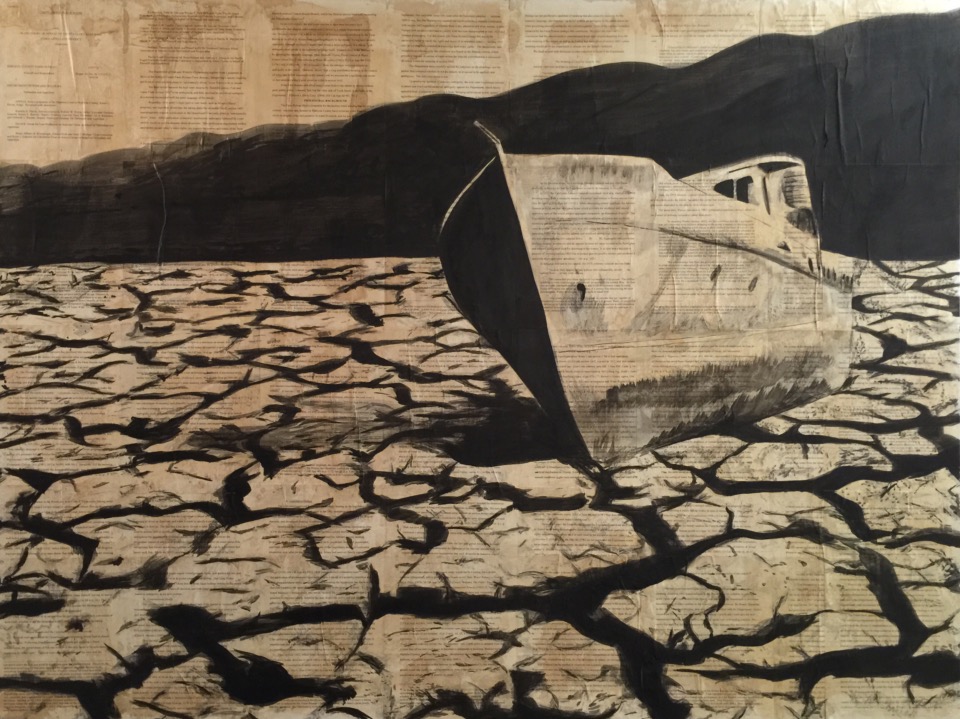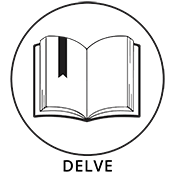
Exhibit 8: California Water Crisis
Jeremy Salvador, 2015
Ink and coffee on copier paper adhered to canvas, 48″ x 60″
Image © 2015, courtesy of the artist
About the Artist
In a work entitled, “Exhibit 8: California Water Crisis,” Jeremy Salvador portrays a landscape created by the multi-year drought in the State of California. He paints in inks on coffee-stained pages of a court case involving California water rights. Salvador depicts a boat that is stranded on a parched lakebed, a powerful metaphor for a population that is ill-equipped to navigate the consequences of climate change. He warns us that without coordinated, proactive measures, we will be left high and dry, fighting over dwindling aquifers and relying on bureaucrats and courts of law for an accounting long past due.
Explore These Artworks
In the artist’s words:
“This piece of artwork is a landscape of a boat sitting on a dry lake bed. It uses pages from SISKIYOU COUNTY FARM BUREAU v. DEPARTMENT OF FISH AND WILDLIFE, one of the many court cases involving California water rights stemming from the long standing drought. The pages are stained with coffee and painted with various levels of diluted calligraphy ink to achieve different gradient levels.”
From Global Footprint Network:
Water scarcity threatens ecological assets. Climate change is contributing to drought which then can reduce the productivity of crop and grazing lands. Recent examples include the drought in California, which has resulted in farmers leaving half a million acres or 200 thousand hectares fallow.
From Earth Day Network:
We discuss the California drought in the following excerpt from our blog. You can view the full blog posthere.
California is facing one of the most severe droughts the state has ever endured. Now entering into its fourth year, the drought has caused the state government to act against water shortages since California State Governor Jerry Brown declared a drought state of emergency back in January of 2014. But eliminating irrigation water deliveries through public canal systems and ordering urban water use to cut back by 25 percent isn’t enough to save this parched state.
Throughout the drought, the agriculture industry has endured criticism for using an unrestricted 80% of California’s water supply. That finally came to an end on May 22 when California State Water Board approved the proposals of farmers in the Sacramento-San Joaquin River Delta to voluntarily reduce their water use.
As the producer of nearly half of America’s food, including fruits (grapes), nuts and vegetables, California’s agricultural welfare is essential for the health of the nation, and possibly the whole world. However, while urban development has depleted nonrenewable aquifers below, the rivers which typically feed on mountain snowmelt from above have been starved as the lack of rain and snow has left mountain tops bare and turned what once were large lakes and rivers into thin streams snaking around newly formed sand dunes.
The constant droughts have put California in a consistent state of crisis. As such, the state has had to finally address long-running issues related to urban and industrial consumption of water, in order to protect communities and water supplies.More creative solutions may have to be employed by governments and communities in order to ensure the state’s vitality going forward. In other parts of the world with coastal cities in an otherwise water-scarce area (the Middle East and Africa), desalination plants have been employed. However, it will be difficult under further drought conditions to keep the cost of water low, and available in large enough quantities to continue to supply agricultural fields and vital ecosystems.
Droughts and water shortages will increase in frequency and severity with climate change. Without sufficient water, plants, animals and human life cannot be sustainable. Californian farmers’ voluntary move to reduce water usages is a step forward to save California.From World Wildlife Fund:
WWF’s work has evolved from saving wildlife and landscapes to addressing larger global threats that threaten our way of life. One of those threats is tackling the dwindling freshwater supply on our planet.
Freshwater is the key ingredient to life on Earth. It is the planet’s most precious resource, fueling everything from the food we eat, to the cotton we wear, to the energy we depend upon every day. Freshwater habitats – such as lakes, rivers, streams and wetlands – house an incredible proportion of the world’s biodiversity: they support more than 125,000 species, from fish to terrestrial animals.
Yet, despite all of this, according to WWF’s Living Planet Report (a health card on the state of the planet), there’s been a 76% decline in freshwater species in the past 40 years.
WWF seeks to address this decline, and change how water is managed around the world. We encourage states relying on the same river to better coordinate their shared freshwater resources, and we advocate for water security in sustainable development. You can help too! Urge global leaders to ratify the United Nations Watercourses Convention to put in place basic standards for cooperation on the use, management and protection of international waters.
Learn more about our freshwater initiatives here.
Reserved for art-interpretive content.
Featured Actions:
* Pledge to not run the water when you brush your teeth
* Pledge to only run dishwashers and washing machines when they are full
* Your pledge will be counted in Earth Day Network’s “A Billion Acts of Green” campaign. Learn more about this campaignhere.
Reserved for future conversations.











